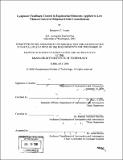| dc.contributor.advisor | Manuel Martinez-Sanchez. | en_US |
| dc.contributor.author | Joseph, Benjamin E. (Benjamin Ethan) | en_US |
| dc.contributor.other | Massachusetts Institute of Technology. Dept. of Aeronautics and Astronautics. | en_US |
| dc.date.accessioned | 2007-01-10T16:41:39Z | |
| dc.date.available | 2007-01-10T16:41:39Z | |
| dc.date.copyright | 2006 | en_US |
| dc.date.issued | 2006 | en_US |
| dc.identifier.uri | http://hdl.handle.net/1721.1/35576 | |
| dc.description | Thesis (S.M.)--Massachusetts Institute of Technology, Dept. of Aeronautics and Astronautics, 2006. | en_US |
| dc.description | Includes bibliographical references (leaves 87-88). | en_US |
| dc.description.abstract | For a typical satellite constellation design problem, sometimes there are two conflicting goals. On one hand one wishes to provide continuous coverage of a particular area. On the other hand one would like to use the minimum number of satellites as possible. For coverage locations nearer the equator, these requirements are easily fulfilled by using a satellite in a geostationary orbit. However, coverage of higher latitude locales is not as effective with geostationary satellites because the viewing angle from the ground to the satellite will be closer to the horizon, which increases the likelihood of loss of signal due to some ground obstacle. Instead, a constellation consisting of satellites in eccentric orbits at high inclination angles, sometimes referred to as Molniya type orbits, can circumvent this problem and provide continuous coverage with very few satellites. Elliptic-inclined constellations have been flown since the 1960s, chiefly by the governments of the former Soviet Union and the current Russian Federation. Not until the year 2000 has such a constellation been flown commercially. | en_US |
| dc.description.abstract | (cont.) With the involvement of a commercial entity in flying constellations of this type, there has been some interest in reducing system costs by applying electric propulsion to spacecraft operating in these types of orbits. However, using electric propulsion for station keeping on elliptic-inclined constellations is not yet well characterized. For example, to maintain continuous coverage of a particular area can require these types of constellations to have a repeat ground track, thus greatly enhancing the effects of tesseral harmonics. Additionally, these orbits typically have a high apogee altitude, which increases the effect of perturbations due to third body point mass effects. Overall it is possible to see station keeping AV budgets much greater than one would typically see for a geostationary satellite. While there is some data on station keeping of an elliptical-inclined orbit using high thrust systems, very little of this appears to have entered the public domain. Furthermore, there seems to be no data for using electric propulsion to station keep elliptic-inclined constellations. Thus, the primary goal of this thesis is to remedy this gap in our knowledge. | en_US |
| dc.description.abstract | (cont.) A generic and easy-to-use software tool based on Lyapunov feedback control and implemented in the Goddard Trajectory Determination System. This tool is used to determine station keeping AV budgets of two different elliptic constellations: John Draim's Teardrop orbit constellation and the Sirius Satellite Radio constellation. | en_US |
| dc.description.statementofresponsibility | by Benjamin E. Joseph. | en_US |
| dc.format.extent | 88 leaves | en_US |
| dc.format.extent | 3514115 bytes | |
| dc.format.extent | 3737727 bytes | |
| dc.format.mimetype | application/pdf | |
| dc.format.mimetype | application/pdf | |
| dc.language.iso | eng | en_US |
| dc.publisher | Massachusetts Institute of Technology | en_US |
| dc.rights | M.I.T. theses are protected by copyright. They may be viewed from this source for any purpose, but reproduction or distribution in any format is prohibited without written permission. See provided URL for inquiries about permission. | en_US |
| dc.rights.uri | http://dspace.mit.edu/handle/1721.1/7582 | |
| dc.subject | Aeronautics and Astronautics. | en_US |
| dc.title | Lyapunov feedback control in equinoctial elements applied to low thrust control of elliptical orbit constellations | en_US |
| dc.type | Thesis | en_US |
| dc.description.degree | S.M. | en_US |
| dc.contributor.department | Massachusetts Institute of Technology. Department of Aeronautics and Astronautics | |
| dc.identifier.oclc | 74279486 | en_US |
